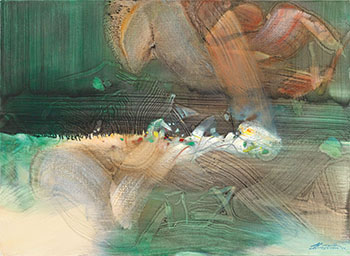ILLUSTRATED:
Pierre Cabanne, Chu Teh-chun , Cercle d'Art, Paris, 1993, color illustrated,
no. 75, pp. 134-135
World Chinese Arts Gazette , Issue no. 4, Yi Mo Culture and Arts
Development Ltd., Shenzheng, Guangdong, July 28, 1995, color
illustrated
Edition des oeuvres des académiciens de l'Académie des Beaux-Arts de
l'institute de France: Chu Teh-chun , Hebei Education Press, Hebei, 2005,
color illustrated, no. 86, pp. 154-155
Pierre-Jean Rémy, Chu Teh-Chun , La Différence, Paris, 2006, color
illustrated, p. 182
Catalogue Note:
LANGAGE D'AILLEURS
CHU TEH-CHUN
Chu Teh-chun began his studies of abstract paintings in the 1950s with inspirations from French artist Nicolas de Staël. Early on, Chu took color concepts to conjure abstract expressions and injected his own thoughts, which gradually developed into his individual style. His early work has been termed as his gemstone stage to describe the pervasive geometric shapes. His later work shifted the focuse on to light, with vibrant colors and broad strokes, sprinkling jewel-like clusters that shimmer in the night sky.
This particular work, was created in 1990. As the result of an ongoing process of artistic exploration and discovery, Chu Teh-chun's artistic trajectory had moved away from introspection towards a more extroverted approach, while retaining the effective use of color and line to create "landscapes of the mind" that had been a constant element in Chu's work throughout his career. By the 1990s, Chu's work had become freed from all inhibition; his spatial composition had become more striking and self-assured, and his use of color was smoother and more elegant. This painting employs Chu Teh-chun's favorite color tones, using a wide range of blue tones in combination with bluegreen. Chu once said that he associated the color blue with the mysterious quality of the ocean and the way it constantly changes, sometimes calm and serene, sometimes wild and violent. Here, Chu's use of blue adds an air of solemnity to what is otherwise a highly dynamic painting.
In this painting, the relationship between composition and color is particularly exquisite. The positioning of an oval composition within a rectangular frame creates a visual contrast between stasis and movement, which is one of the characteristic features of Chu's art. Rather than just adding large swathes of blue or green to the canvas, Chu has flourished a large brush back and forth, using a combination of long and short strokes, to portray the zen-like flow of blue and the magnificent stillness of green. The light reflected in the painting seems to come from a far-distant, as yet unexplored source. Having traveled such a long distance, the rays of light are unable to fully dissect the spatial and color composition of the work; instead, they seem to "float" over it, like air. The darker dots and lines, with their manic energy, are the "energy source" for the painting's dynamism, guiding the viewer's gaze around the canvas. The large patches of dark color tones that dominate the corners of the painting ensure that, even when the fantastical variations in blue and green color tone are contained and stabilized by black brushstrokes, this calmness does not degenerate into a sense of loneliness or isolation. At the same time, the faint touches of white or yellow that can be discerned in the blue act, through the medium of the viewer's perception, to suggest the emission of light, while the extended perspective provides enhanced freedom for the play of color. The patches of indigo constitute the soul of the painting; they represent the self-observation of poetic metaphor, and hold together the poetic rhythm of the work, keeping its precision and restraint. These color elements take the center of the painting as their axis, spreading out from it in interleaving layers. The dense brushstrokes and intense colors safeguard a sense of emotion and internalized memory that is as fine and precise as a point of light; the individual's will is placed within the majestic dynamism of life. This work embodies a progression from taking inspiration from the material world to taking inspiration from the soul, so that, when the artist puts down their brush and stands in front of the canvas, the sense of joy is undiminished.
Chu dedicates his life to art. He is focused and committed to art without distraction. Through his paintings, he shares with the viewers his life: the small pieces as well as the important chapters. Even though they are abstract, the surging emotions, powerful concepts, and his spiritual contemplation of the universe over and again lead the viewers to travel into his works and leave feeling deeply touched. The ancient philosopher Lao Tzu once said, "The most beautiful sound is soundless; the most beautiful image is without an image." Within and through his works, Chu has expressed exactly this poetic and aesthetic concept to art lovers around the world. "WHEN I AM PAINTING, I AM ALWAYS DRAWING ON MY EXPERIENCES WHEN TRAVELING
AT DIFFERENT TIMES OVER THE COURSE OF MY LIFE. SOME PAINTINGS ARE THE RESULT OF
A SUDDEN, IRRESISTIBLE IMPULSE; SOMETIMES, A LOT OF TIME HAS ELAPSED, AND I MAY
EVEN HAVE THOUGHT THAT I HAD FORGOTTEN THE MEMORIES OF THAT JOURNEY, BUT
THEN, STANDING IN FRONT OF THE CANVAS, IT ALL COMES FLOODING BACK. REGARDLESS
OF WHETHER I AM INSPIRED DIRECTLY BY THE BEAUTY OF THE SCENERY, OR WHETHER THE
INSPIRATION COMES FROM SOME DEEPLY-BURIED INTERNAL MEMORY, WHENEVER I STAND
BEFORE THE CANVAS, THE EMOTIONS START TO WELL UP."
– CHU TEH-CHUN
